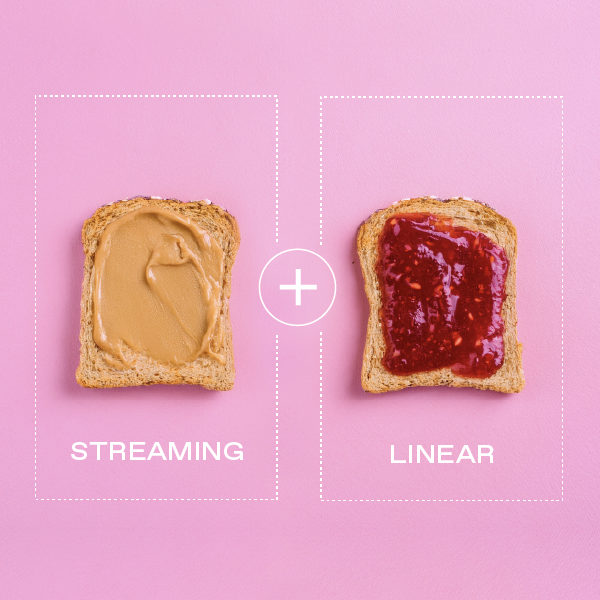
Streaming TV is the Future. But the Future Isn’t Always Tomorrow.
Some marketers hold the misconception that ads on streaming TV can deliver the laser-sharp precision of Facebook combined with the scale of linear TV. Streaming does offer unique advantages, but the medium hasn’t matured enough to beat digital on precision, or traditional TV on scale.
What do we mean by streaming TV?
Over-the-top (OTT) TV is streaming video delivered over the internet, independently of a traditional pay-TV service, irrespective of device. There are subscription-based channels like Netflix, transaction-based channels like Google Play, as well as ad-supported channels like Sony’s Crackle. Hulu blends a couple of those models; you can opt to watch ads or pay for ad-free content. eMarketer forecasts that just over 61 percent of the US population will use OTT services this year.
The other type of streaming TV is connected TV (CTV), or TV with access to the internet. Connected TV includes smart TVs and devices like Roku or Apple TV. The same eMarketer research said just over 57 percent of the US population will be connected TV users this year.
When marketers consider adding a new performance channel to their marketing mix beyond search and social, they often feel more comfortable with streaming TV (OTT & CTV) than with linear TV (broadcast and cable). This is because streaming feels more like digital video: Content is delivered to the IP address of a specific device, viewers are unable to skip over ads, and there are high completion rates. Streaming, however, is much more complicated to target, buy, deliver, and measure than other digital platforms.
Streaming isn’t the holy grail (yet)
Targeting varies among different streaming providers. Some are limited to the same targeting parameters as can be found in linear TV (i.e. broad demographics). Others will allow the advertiser to slice and dice by just about anything (e.g. leveraging Oracle data on a Hulu buy). Because targeting parameters vary (wildly), the buying process is more fragmented and complicated. To reach a large audience via streaming TV, advertisers need to cobble together many different small buys, each with its own buying instructions, and each particular to the platform.
When it comes to delivery, controlling the frequency cap can be hardest. We’ve all experienced seeing the same ad over and over during a binge session of our favorite series. That can potentially annoy your customers and damage your brand. A much more serious delivery issue is fraud. Conviva determined up to 47% of ad attempts -- across ad request, decisioning and selection, ad creative delivery, and creative playback -- may not make it to the viewers’ screens as intended.
As for measurement, marketers need more than just completion rate; they need to demonstrate the impact on sales (or other KPIs). Traditional “baseline+lift” models are defunct since most streaming TV is watched on demand. While IP-level matching is a sound framework for streaming measurement, there are a plethora of potential wrenches in the spokes (like the transition from IPv4 to IPv6, or simply the reality that people may watch an ad at home and visit the advertiser site on a computer at work). The use of device graph data is not a silver bullet type of fix (just yet).
Possibly most important of all, streaming offers far less scale than linear TV.
Marketers who watch a lot of streaming content themselves (i.e., as consumers) get the sense there’s a lot of reach. That’s an illusion. Right now, approximately $70B will be spent on linear TV ads while only about $3B will be spent on streaming. Viewers are splitting time between different apps and providers because oftentimes the content they want isn’t centralized on one alone, and this can be a problem for marketers if their approach is to work directly with only one or even a few streaming services.
So what’s a marketer to do in the meantime?
You may be thinking that you’ll just wait on the sidelines until some of the challenges have been solved. If you do, you’ll miss out. Your video media plan should be diversified -- with a mix of digital, streaming TV, and linear TV ads, all informed and optimized by data.
Streaming is exciting because it’s easy to get started, flexible with ad lengths, and provides performance metrics like completion rate that are easy to digest. You should be testing OTT & CTV on a platform that has access to inventory across a wide range of streaming services. That way, you find new audiences and figure out which networks, dayparts, and creatives work best.
Marketers who’ve added linear TV advertising in addition to streaming have been able to get reach and scale, as well as experience its halo effect: The increase of awareness driven by TV improves the performance on other (digital) channels, e.g. higher search quality score. The future of TV isn’t quite here yet -- but that doesn’t make the present unattractive.

Philip Inghelbrecht
I'm CEO at Tatari. I love getting things done.
Related
Why Linear + Streaming Work Better Together
When one advertiser shifted from a dual-channel TV strategy to streaming-only, performance quickly declined. See what happened when they turned linear back on.
Read more
Conversations on the Croisette: Tatari Explores the Future of TV Media Buying at Cannes
Speaking at this year’s Cannes Lions, Tatari took the stage to show that performance TV can be both measurable and creative—all while leveraging AI to plan smarter and drive stronger results.
Read more
Is Dynamic Ad Insertion Reality or BS? Publishers Weigh In
Can Dynamic Ad Insertion (DAI) really change how we watch TV ads? Publishers say it’s the future. Discover why DAI could rewrite the rules of TV advertising.
Read more


